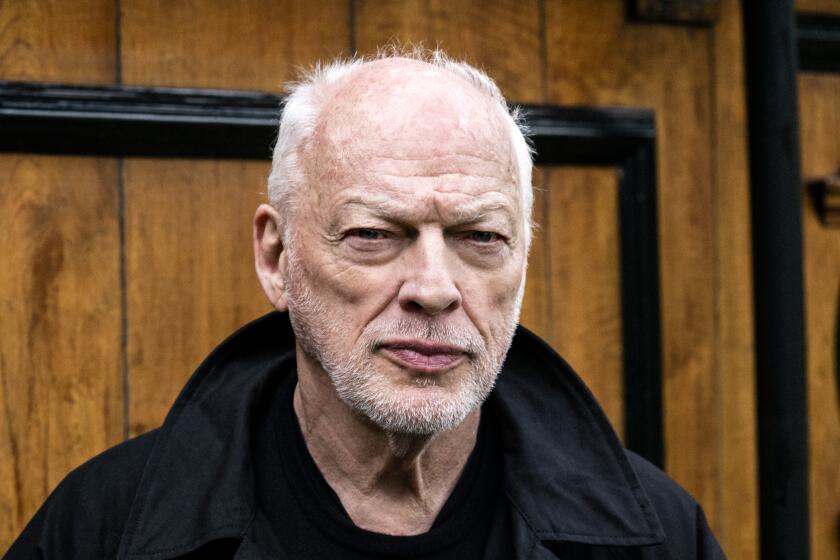Sonny Rollins, nearly 80, looks to the future
- Share via
In the mid-1950s, through the sheer gale force of his surging theme-and-variation solos, Sonny Rollins turned the tenor saxophone into jazz’s iconic horn. Before Rollins, the trumpet and alto saxophone shared pride of place in jazz’s frontline with the tenor.
That’s not to disregard the seminal contributions of tenor patriarch Coleman Hawkins, Lester Young’s cool revolution, or Dexter Gordon’s relaxed bebop swagger. The Harlem-raised Rollins, who performs at Walt Disney Concert Hall on Sunday night, is the first to acknowledge that he came into his own in the midst of a golden age, when singular masters representing jazz’s entire history were active and accessible.
“You can look at that famous photo, ‘A Great Day in Harlem,’ and those were some of the great jazz artists performing all at the same time,” said Rollins by phone from his home in New York’s Hudson River Valley. “You could hear Willie ‘The Lion’ Smith, Charlie Mingus, Lennie Tristano, Illinois Jacquet, Don Byas. I was really blessed to be born when and where I was, right in the midst of all this great music.”
Largely self-taught, Rollins absorbed everything and forged his own brawny sound, emerging after apprenticeships with modern jazz progenitors Bud Powell, Thelonious Monk and Miles Davis as a creative force with a gift for surgically subdividing rhythms.
Equally visionary as a composer, Rollins has written nearly a dozen jazz standards, including “Oleo,” “Doxy,” “Airegin,” “Tenor Madness” and the calypso anthem “St. Thomas,” the first of several tunes evoking his Caribbean heritage. His influence remains pervasive among jazz players on every instrument, inextricably woven into the syntax of the post-bop era.
As his 80th birthday approaches on Sept. 7, Rollins has lost none of his improvisational potency. Standing nearly 6-feet-2, he strides the stage with the authority of an Old Testament prophet, his trademark dark shades standing out in sharp relief against his snowy beard and white halo of an Afro. While he’s cut back on touring in recent years, when he picks up his horn Rollins often delivers epic performances marked by his buoyant humor, athletic endurance and seemingly infinite flow of ideas.
Rollins put his late-career fluency into vivid perspective with the second release on his Doxy label, 2008’s “Road Shows, Vol. 1,” a live anthology culled from concerts between 1980 and 2007. Considering that he’s a self-professed perfectionist who’s famously uncomfortable in the recording studio, it’s not surprising to hear Rollins describe the process of choosing the seven “Road Shows” tracks as “torture.” But his choices resonated with critics, many of whom hailed the album as one of the finest releases of the decade. As for Rollins, he aspires to new heights.
“When you’re hoping you’re really going to sound great and you listen and you get sort of dashed, it can get discouraging,” Rollins said. “Hopefully I’ll be able to do something better than that in the future.”
As a bandleader, Rollins has long kept himself inspired by maintaining an ever-shifting balance between comfort and novelty. After many years working with pianists, he returned to a pianoless format in 2007, while retaining key members of his group. Pioneering electric bassist Bob Cranshaw has anchored Rollins’ ever-evolving ensemble on and off for nearly five decades, and percussionist Victor See-Yuen, who hails from Trinidad and Tobago, started touring with Rollins in the mid-’90s.
The young Chicago drummer Kobie Watkins has gained national attention in the past two years through his work with Rollins and vocalist Kurt Elling. And the band’s latest addition is guitar star Russell Malone, who made his debut with Rollins in Berkeley on Thursday.
Rollins wasn’t the first jazz musician to employ a pianoless band, but no one save Ornette Coleman has explored the harmonic freedom afforded by the keyboard’s absence with more thrilling results. Rollins had already established himself as the era’s dominant tenor voice when he started recording a series of epochal trio sessions with bass and drums in 1957, including “Way Out West” (Contemporary), “A Night Live at the Village Vanguard” (Blue Note) and “Freedom Suite” (Riverside).
He returned to the pianoless format for 1962’s “The Bridge” (RCA Victor), the classic record that marked Rollins’ return to the scene after a two-year hiatus spent practicing on the Williamsburg Bridge. (“After making all those records…I had something to live up to and felt I needed some more ammunition,” Rollins explained.)
Rather than claiming his pianoless bands as an innovation, Rollins puts the format into historical context.
“The guitar can play the role of providing some harmonic structure, without being as overwhelming as the piano,” Rollins said. “When you think about bands in New Orleans marching through the streets, they didn’t have any piano, so I’m probably being very traditional.”
More to Read
The biggest entertainment stories
Get our big stories about Hollywood, film, television, music, arts, culture and more right in your inbox as soon as they publish.
You may occasionally receive promotional content from the Los Angeles Times.










